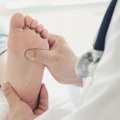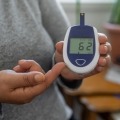5 Ways to Lower Triglycerides if You Have Diabetes
By April Hopcroft
.jpg) Many people with diabetes have high levels of triglycerides, a type of circulating fat in the blood. We spoke to cardiologists to discover lifestyle changes to lower triglyceride levels and reduce the risk of heart disease.
Many people with diabetes have high levels of triglycerides, a type of circulating fat in the blood. We spoke to cardiologists to discover lifestyle changes to lower triglyceride levels and reduce the risk of heart disease.
Like high blood pressure, high triglycerides can be considered a “silent killer” because they often don't cause any noticeable symptoms right away – yet over time, high triglyceride levels can increase the risk for heart attack, stroke, pancreatitis, and liver disease. Fortunately, it’s possible to lower triglycerides through simple lifestyle changes – many of which overlap with the basics of diabetes management.
Triglycerides are a type of fat that comes from the foods we eat and circulates in the blood. High triglyceride levels (also called hypertriglyceridemia) are common in the general population and especially in people with type 2 diabetes. A 2020 study found that roughly 25% of US adults with diabetes or cardiovascular disease who were treated with a statin had high triglycerides. While LDL cholesterol (the “bad” kind of cholesterol) has fallen in recent decades, triglyceride levels continue to rise.
If you’re concerned about your risk for high triglycerides, your healthcare provider can order a blood test to measure triglycerides along with cholesterol (more on this below).
The relationship between cholesterol and triglycerides
Both cholesterol and triglycerides are lipids – a type of a fatty substance – that circulates in the blood. Triglycerides are a type of fat used for energy, while cholesterol is a waxy compound made by the liver. Since cholesterol can’t be dissolved or mixed into blood on its own, the liver adds triglycerides and proteins called lipoproteins to help move cholesterol throughout the body.
Any level of insulin resistance leads to changes in lipid panels, explained Dr. Nieca Goldberg, cardiologist and founder and former medical director of the Joan H. Tisch Center for Women's Health at NYU.
The metabolic disturbance in insulin resistance, prediabetes, or diabetes leads to an increase in very low density lipoprotein, the protein that carries triglycerides. Along with high triglycerides, it’s common for people with diabetes to have decreased HDL, the “good” kind of cholesterol.
Why are triglycerides harmful?
High triglycerides can promote plaque buildup in the arteries. While plaque is often thought of as a driver of heart disease, high triglycerides are “not just a heart problem,” noted Dr. Claire Sullivan, assistant professor at Case Western Reserve University School of Medicine. Indeed, elevated triglyceride levels can cause stroke and peripheral arterial disease (PAD), too.
Fatty liver disease is another potential consequence of high triglycerides; this happens when excess fat builds up in the liver. Very high triglyceride levels can also increase the risk of pancreatitis.
How are triglycerides measured?
A series of blood tests called a lipid panel measures the levels of different fatty substances in your blood, including cholesterol and triglycerides.
Guidelines recommend a lipid panel at diabetes diagnosis and at least every 5 years for people under 40 years of age. For people aged 40 years and above or who are starting a statin for high cholesterol, the American Diabetes Association recommends re-testing four to 12 weeks after starting treatment and annually to make sure you’re on track.
In order to properly assess triglyceride levels, it’s important to fast before a lipid panel, noted Sullivan. This means you shouldn’t eat or drink anything after midnight on the night before your lipid panel.
After your lipid panel, your healthcare provider will discuss the results with you. Triglyceride levels are classified as the following:
-
Normal: Less than 150 mg/dL
-
Borderline high: 150 to 199 mg/dL
-
High: 200 to 499 mg/dL
-
Very high: Above 500 mg/dL
Risk factors for high triglycerides
 In addition to diabetes, several other health conditions can increase triglyceride levels in the blood. These include overweight and obesity, kidney disease, liver disease, and thyroid disease.
In addition to diabetes, several other health conditions can increase triglyceride levels in the blood. These include overweight and obesity, kidney disease, liver disease, and thyroid disease.
Some medications can also increase the risk of high triglycerides. These include medications to treat high blood pressure, breast cancer, and HIV. Steroid medications are also widely known to increase cholesterol and triglycerides, Sullivan noted.
According to the National Institutes of Health, people living with HIV or genetic lipid metabolism disorders, as well as people of South Asian descent, are more likely to have high triglycerides.
Strategies to reduce triglycerides
Treatment for high triglycerides overlaps with general diabetes best practices: lowering blood glucose, maintaining a healthy weight, eating nutritious foods, and getting enough physical activity.
While managing cholesterol generally involves statin treatment, both Goldberg and Sullivan stressed the role of lifestyle changes in reducing triglycerides.
“One of the components of cholesterol that’s most receptive to diet and exercise is triglycerides,” Goldberg said. "A diet that is low in sugar, simple carbohydrates, and saturated fats combined with aerobic exercise can help lower triglycerides. The influence that these lifestyle changes have on triglycerides are greater than those on LDL cholesterol."
1. Maintain a healthy weight
Triglycerides increase with weight gain and decrease with weight loss, Sullivan said. Therefore, maintaining a healthy body weight is a key step toward reducing triglycerides.
In addition to diet and exercise, there are many newer drugs approved for diabetes that also provide weight loss – namely, GLP-1 receptor agonists and other incretin medications.
2. Limit the amount of alcohol you drink
 Alcohol contains a lot of sugar and calories, so excess alcohol intake can raise triglyceride levels.
Alcohol contains a lot of sugar and calories, so excess alcohol intake can raise triglyceride levels.
While some research has suggested that having one drink each day can be heart healthy, Goldberg cautioned that the evidence hasn’t panned out. In fact, she said, drinking one drink a day has been shown to raise blood pressure.
Guidelines recommend that if you do drink alcohol, to do so in moderation. That means no more than one to two drinks per day for men and one drink per day for women.
3. Increase the number of whole foods you eat
While Sullivan doesn’t recommend following a specific diet, she noted that Mediterranean eating patterns tend to be best for lowering triglycerides and improving heart health. This means eating a lot of fresh fruits and vegetables and lean proteins, and avoiding proccessed foods.
Whole grains are another key part of the Mediterranean diet – these include foods like whole wheat bread, oats, and brown rice. It’s a good idea to limit foods made with white flour, such as white bread and pasta.
Eating more whole foods also increases fiber intake, which has a number of benefits on gut health and reduces cholesterol.
“Fiber is a great way to lower cholesterol and triglycerides,” Sullivan said.
4. Opt for healthy fats
.jpg) Dietary fats exist on a wide spectrum, from trans fats found in many processed foods to the unsaturated fats found in plant foods.
Dietary fats exist on a wide spectrum, from trans fats found in many processed foods to the unsaturated fats found in plant foods.
Sullivan noted that some fats are good fats, such those found in avocados, olive oil, and lean meats like chicken and fish. For instance, fish and other seafood contain omega 3 fatty acids, which have been shown to benefit the heart.
If you choose to eat dairy, Goldberg advised selecting lower fat options and making sure dairy isn’t the main part of your diet.
For instance, swap full-fat yogurt, cheese, or milk with lower fat versions, bearing in mind that lower fat versions of yogurt products often have higher amounts of added sugar.
5. Engage in regular physical activity – and make it something you enjoy
Generally, aerobic activity is best for triglyceride lowering. Aerobic activity is exercise that involves rapid movement of large muscles and increases your heart rate.
The American Heart Association recommends 150 minutes of moderate intensity aerobic exercise or 75 minutes of high intensity exercise each week. Above all, Goldberg suggested choosing a form of activity you enjoy: walking, jogging, dancing, swimming, and biking are all good options.
Research suggests that enjoying physical activity is a strong motivator – after all, if you’re looking forward to a weekly dance class with friends, you’re probably more likely to keep going back.
Strive to incorporate some weight or resistance training as well, Goldberg and Sullivan said.
“Strength training has its benefits,” Goldberg said. “It builds muscle, decreases body fat, and increases power and endurance to further support aerobic activity.”
Likewise, Sullivan explained that resistance training is important because it increases metabolic rate, even after you stop exercising, which can promote long-term weight loss or maintenance.
“Even small resistance weights are good for increasing metabolic rate,” Sullivan said.
Reducing triglyceride levels: The bottom line
High triglyceride levels are very common among people with diabetes and can increase the risk of heart disease and other complications. Luckily, there are different lifestyle changes that can reduce triglyceride levels, many of which overlap with general diabetes management.
“The cornerstone of managing triglycerides is what people eat, along with exercise, weight loss, and medication if necessary,” Sullivan said.
Ultimately, Goldberg urged people with diabetes to be aware of their triglyceride levels.
“Triglycerides are like the forgotten particle,” she said. "It's no joke – high triglycerides are associated with increased risk for cardiovascular disease in individuals with diabetes. If your triglycerides are elevated please ask your healthcare provider about the best way for you to lower your triglycerides."
While managing cholesterol is often a first priority for people with diabetes, triglycerides may fall by the wayside. Thus, it’s extra important to advocate for your own health and bring up triglycerides as part of a full lipid panel at your regular healthcare visits.
Learn more about diabetes and heart health:
-
Connecting the Pieces for Better Cardiovascular, Kidney, and Metabolic Health
-
Taking Care of Your Feet: How to Exercise Safely With Peripheral Artery Disease







